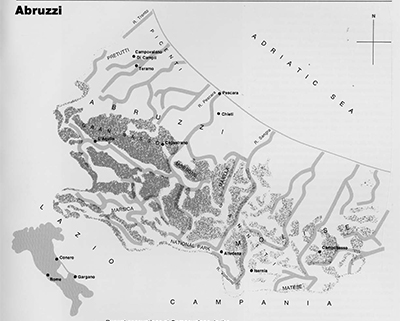 Recent excavations at Campovalano, in the Abruzzi region of Italy, have reaffirmed the existence of a little-known culture which flowered in this area around the 6th century B.C., and which raises interesting questions for the archaeologist as no comparable culture is known to exist elsewhere in the archaic world. Whence it came; who were its representatives; and why it vanished, never to revive—these formidable puzzles are worthy of intense investigation, for the technical and artistic credentials of these mysterious people of the Middle Adriatic culture are indeed impressive.
Recent excavations at Campovalano, in the Abruzzi region of Italy, have reaffirmed the existence of a little-known culture which flowered in this area around the 6th century B.C., and which raises interesting questions for the archaeologist as no comparable culture is known to exist elsewhere in the archaic world. Whence it came; who were its representatives; and why it vanished, never to revive—these formidable puzzles are worthy of intense investigation, for the technical and artistic credentials of these mysterious people of the Middle Adriatic culture are indeed impressive.
The inhabitants of this area appear for the first time in historical records several hundred years later, by which time the earlier cultural tradition was extinct; however, an account of these later peoples and their legendary origins may give us some perspective on the questions raised in Campovalano.
The more usual forms made at Santa Apolonia are the tinajera, the tinaja, the ol/a, the apaste, the tamalero (for cooking tamales), the brasero (for burning charcoal), the batidor (for cooking beans) and the comal. The brasero sits upon a low pedestal or foot which is formed by placing a ring of wet clay on the bottom of the inverted vessel when the clay has become leather-hard, thence modelling it precisely as with the collar of the olla. The larger-sized comales which may run up to twenty-four inches in diameter are deeper, less shallow, than the majority of those turned out in other pottery centers but are among the handsomest of the country. Sound craftsmanship in all of their forms, which indeed might well be called the hallmark of Santa Apolonia ware, is evident at a glance.
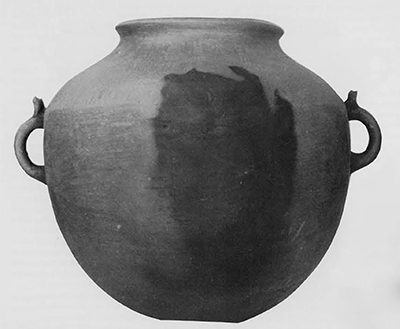

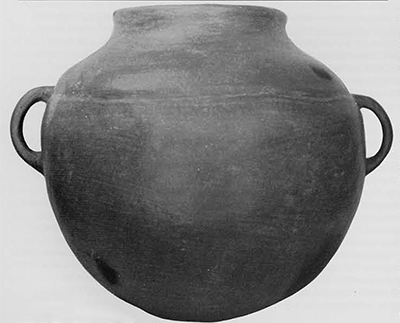
While up the valley from Santa Apolonia the women of the aldeas and mountain sides turn out a tinaja of a pale, buff-firing clay which is reminiscent in form of the beautiful ovoid shapes made in Chinautla, the general form of Santa Apolonia vessels as made in the village proper is globular. This makes for a sturdy, practical, utilitarian vessel, virile and honest to the core, and these virtues gain for them a wide distribution. From the Thursday market at Tecpan, whither as many as six to eight hundred may be transported in the early morning light, commerciantes carry them off in great numbers toward the southwest coast, and in lesser numbers to the Capital. to Antigua, to Chimaltenango, and to the many smaller towns and villages nearby.
The 4th century B.C. was a crucial one for the infant Roman civilization: Rome saw at stake not only her tenuous political power but her very way of life, for if the Etruscan world from which she had made herself independent had from the beginning shaped the basis of her culture, she now faced rivals of quite different formation, just emerging from barbarism. These powerful and temporarily victorious challengers (they had defeated Rome at the Battle of the Caudine Forks in 321 B.C.) were the Samnites.
According to tradition, the Samnites were a pastoral tribe who, by divine impulse, had migrated southward from the Sabine Mountains and taken up a new home in the plains on the eastern side of the Matese massif, which marks the watershed between Campania and Molise. Shortly thereafter, they had spread over a large part of southern Italy and thus became the largest ethnic group on the peninsula. Various elements in the historical tradition allow us to set the supposed migration in the latter half of the 6th century B.C.
Modern historiography has considered this tradition a myth; however, there may be elements of truth in the Samnite claim that the three tribes which led the war against Rome (the Pentri, the Caudini and the Irpini) not only derived from common Sabine stock, but were closely related to other tribes of pastoral background inhabiting the Adriatic coast and part of its hinterland from Monte Conero down as far as the Gargano peninsula. Furthermore, the tie of kinship has been extended to large numbers of tribes in central and southern Italy, identified as the Italic peoples.
The Italic people were present along the backbone of the Apennines even before the date traditionally ascribed to the Samnite migration, but only as nomads following their herds; it may be that the migration itself marked the end of this nomadism (not abandoned by all tribes, however) and the choice of settlements for sedentary pastoral life. Be that as it may, the Italic people who colonized the present-day Abruzzi were noteworthy for their stubborn devotion to the old ways: in fact, two centuries after the migration they still preserved the toughness and primitive outlook of their forebears.
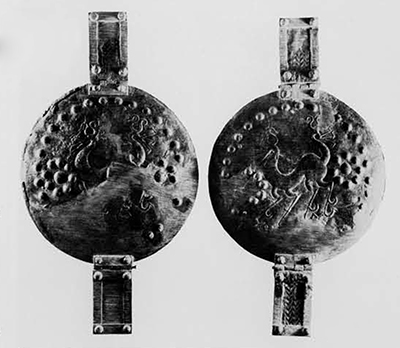
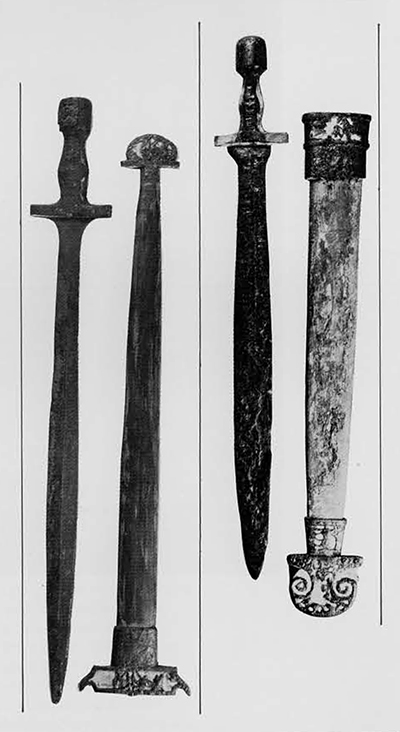
Sword from Campovalano.
By this time, small communities based on kinship ties developed and formed elements in larger tribal units whose foundations rested on a common cultural matrix and common religious cults. However, outside the tribe proper, broad ethnic identification was very loose. This is clearly demonstrated in the Samnite Wars, in which a rather secondary and never determinant role was assigned to the Italic populations of Abruzzi who lacked the firm cohesion of the Samnites.
If such an outline of the social background of Abruzzi twenty-five centuries ago is not very illuminating, it fits the archaeological picture perfectly: from the time of the migration until the beginning of the 3rd century B.C. there is no trace of epigraphic evidence, very little evidence of trade with other economic areas, and virtually no evidence of artistic or iconographic tradition among the Italic people of Abruzzi.
Such a rough cultural situation was due partly to the nature of the area itself, just fit for the seasonal use of shepherds. The economy of the area seriously limited the possibility of cornmercial, and consequently of cultural exchange, which would have been difficult in any case, given the scarcity of passes in the surrounding mountains and the few landing sites on the coast. Undoubtedly, however, the essential cultural features of the ancient Italic Abruzzi were determined by the pastoral character of its tribes: shepherds can assimilate only a few modest cultural elements compatible with their simple, non-sedentary way of life.
If, then, for an effective Italic expression in the cultural world we must wait for its inclusion in the greater Hellenistic-Roman “koine,” striking indeed is the contrast between this elementary society and the situation we find in Abruzzi in the centuries preceding the arrival of Italic peoples.
Among the earlier populations of Abruzzi, the ancient historians have singled out the mythical Sikels and the Liburni. The latter inhabited the coastline between the Tronto and Pescara Rivers, where they may have arrived from the opposite shore of the Adriatic. Since it would be premature to call by either name the cultures dating between the 7th and 6th centuries B.C., which recent archaeological research has brought to light, scholars prefer to give them the less specific name of Middle Adriatic Cultures.
The existence of singularly evolved cultures on the Adriatic coast of Italy could have been established a long time ago if certain inscriptions with graphic and linguistic peculiarities, which constitute a separate chapter in the most ancient epigraphy of central Italy, had been properly evaluated. Antiquarians in Teramo had pointed this out a hundred years ago, but the inscriptions were largely ignored by scholars; since then, many more such documents have been discovered in regions other than Teramo—in the province of Chieti and along the banks of the River Pescara down to the valley of the Peligni. Among this last group is an inscription incised on one of the two small pillars flanking the famous Warrior of Capestrano.
The Warrior, assigned to the second half of the 6th century B.C., is important for dating a whole series of finds in the period between the middle of the 6th and the first decades of the 5th century. Once we have fixed this chronology and consequently verified the fact that the people living along the coast of Abruzzi knew the alphabet, we have still to determine to what group their language belongs: whether related to the Italic dialects (thus being one of their earliest documents) or different from them. The solution to this problem would also make it possible for us to assign an ethnic denomination to these peoples and characterize them either as non-Italic tribes, to be considered indigenous vis-a-vis the Italic immigrants, or Italic early-comers who moved to the region in a migration preceding the traditional one. The work of the linguists has not yet provided any definite answers, but archaeology has clarified some of the cultural aspects, starting with an analysis of the Warrior of Capestrano.

Bronze oinochoe of Rhodian Type.
Decorated pottery pyxis from Campovalano.
Ceremonial pottery brazier from Campovalano.
The first scholar to publish this statue, the late Giuseppe Moretti, realized that it must be set in context with a special category of monuments, the stelae: “This monument which shows a figure in the round, within the framework of a stela.” It has been proven recently that the type of a standing male statue was elaborated by some cultures of the Italian peninsula independently from similar representations which matured in the Aegean world. This hypothesis is confirmed by some finds in Abruzzi, which seem to constitute a transition from the series of anthropomorphic stelae—the earliest examples of which are to be found in the eastern Mediterranean—to the conclusion represented by the Warrior of Capestrano. This is not to say that the Warrior ascribes to the land in which it was found the honor of sealing this evolution with a distinctive final mark; but it is significant that, in the context of Abruzzi cultures, such evolution is documented.
The Warrior exemplifies a distinctive figure style for which we are unable, at the present state of our knowledge, to find acceptable parallels in other cultures. However, we have collected evidence which shows that the art style expressed in this famous sculpture is not an isolated phenomenon, but is found in a large area extending from the coast of Abruzzi westward to the Marsica area, just short of Latium; so far, however, the Warrior represents the greatest and most advanced expression of this style. We note the technical expertise of the artist, who was able to create a monument more than two meters high. He does not appear to emphasize anatomical details, but shows rather a synthesis of volumes so that the human scheme closely approximates the form of pure architecture.
The Warrior is also one of our most comprehensive documents of archaic armor; in fact the artist has covered his synthetic structure of volumes with highly detailed representations of weapons. The disk cuirass, tied to the body with a complicated system of belts, is of particular relevance to our investigations. This type of armor, found also outside the Abruzzi region, was very popular in Abruzzi around the middle and lower course of the Sangro River. It represents a product of highly skilled handicraft, probably deriving from areas of great metallurgic tradition such as those on the west, or Tyrrhenian, coast of Italy.
The sword also must derive from production centers of very high technical competence; faithfully reproduced on the Warrior, many examples of such swords have been found in the necropolis of Alfedena excavated two years ago, as well as in the recently excavated necropolis of Campovalano.
Campovalano is a small village in the township of Campli, about twelve kilometers from Teramo, an area which in ancient times was settled by the Pretuttii—a small tribe belonging to the larger group of Picenian Italic peoples. Whether the Pretuttii are to be considered Italic themselves, or whether their presence in the area preceded the arrival of the Italic people, is a question we cannot answer in this present article.
The few seasons of excavation carried out so far at Campovalano have made it possible to ascertain the great size of the necropolis and the wealth of the tombs, but we have not yet been able to establish a chronological sequence for the burials—which can be dated tentatively in the 6th century B.C., pending a more detailed analysis of the material.
We have found, in addition to weapons, bronze vessels in such quantity as to be compared only to the richest Etruscan cemeteries: household utensils, cauldrons, plates, and also vessels of a more refined usage—for mixing wine, for drinking and for straining liquid mixtures. The most recent finds have brought to our attention personal ornaments of very fine manufacture: a large rectangular pendant is no doubt one of the most important ivories found in the tombs of Italy. in addition, the pottery is by no means inferior to the bronze, either in technical accomplishment or refinement of taste. Made of clay similar to the Etruscan Bucchero ware—dark gray in the interior, with a black glossy surface—it imitates some forms of Etruscan pottery, but also develops distinctive forms of its own; among them a series of cups superimposed to form a sort of pyxis and great jars pierced all around, which we suppose to be braziers possibly for ceremonial use.
These vases bear some decoration in the so-called “orientalizing” style, very popular in the 7th century B.C. and continuing in some areas into the following century. There are incised human figures, animals, mythical creatures, geometric and floral motifs, as well as figures modeled in the round and applied to the body of the vase. A very elegant human stylization, of which numerous examples were found, suggests less the taste of an ancient potter than the urbane culture of our own modern art.
Our conviction that the metal objects were imported is based mainly on the observation that in elementary economic systems, a handicraft tradition is connected with the presence of natural raw materials. This condition does not obtain in the Abruzzi region, where there is no trace whatsoever of copper or tin mining and where the very modest working of copper, hammered iron and precious metals is strictly for local use, as it is all over Italy today. Some of the characteristic bronze forms excavated at Campovalano in sufficiently relevant quantity are certainly imported, and the identification of their manufacturing source will be of fundamental importance to the understanding of many elements of Middle Adriatic culture.
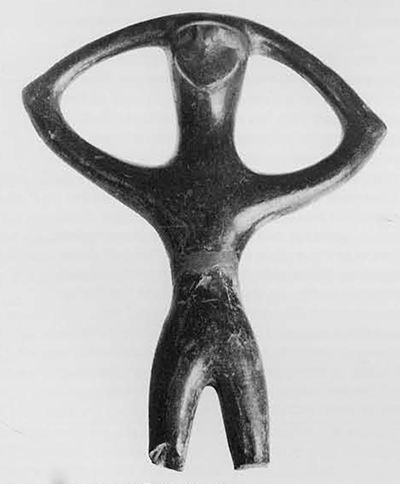
For another problem of equal interest, however—the routes by which these products reached Abruzzi—a solution can be suggested. There doubtless was more than one road. We know that in the southern area there was a route marked by the Sangro River, starting from the ravines of what is now the Abruzzi National Park, and touching Alfedena where the Volturno River links it to the Campanian side. Along this route must have come the cuirass disks, or at least those specimens found along the Sangro and its tributaries, for such disks as we have seen in the sculpture from Capestrano are completely absent in burials north of the Pescara River on the Adriatic side of Abruzzi. This exclusive presence may be due to a detail of local costume. On the other hand, some elements of armor—swords and daggers of iron inlaid with ivory—were common both to Alfedena and Campovalano.
Though we can conjecture a single source for these metal objects, based on similarities of workmanship, it is difficult to suppose that they arrived at Campovalano (in the basin of the Tronto River) from the Sangro River basin. Produced in a single center, they were then sent along different routes to the tribal markets requesting them; for the trade we see documented in Campovalano the route must have been that marked by the softly rolling hills which accompany the Abruze-Marchigiano littoral—the same route which brought to Abruzzi, not only these weapons, but all the Tyrrhenian and overseas products found in the trading ports of the Marches region, of which Numana, just below Monte Conero, is the best known.
Minor commercial ties between the Tyrrhenian and the Adriatic regions may have been possible through the valley of the Pescara and Tronto Rivers, which have their headwaters very close to one another and to those of the Velino River, which flows into the Tyrrhenian Sea; but the mountain barriers through which the rivers have dug their courses certainly were a great obstacle to commercial traffic, at least for a large part of the year. There is also no trace of such traffic being carried on by the nomad shepherds (ancestors of the later Italic tribes who settled the region), who in their wanderings could have constituted a link among the people with whom they came in contact.
Whatever the origin of the tomb equipment and of the abundant imported jewelry, and whatever the trade routes over which they came, another question rises immediately: What could this country, so poor in material resources, have offered in exchange? Nothing indicates the existence of an agricultural activity great enough to stimulate a flourishing commerce. It seems difficult to believe that such a trade could have been adequately supported by products of stockbreeding; though this activity still characterizes the region, it has never played a major economic part. Such a role might be attributed to the only mineral found in any quantity in Abruzzi, bitumen. Used in classical antiquity mostly to caulk ships, it is still found today at Scafa, near Chieti, in a very ancient mine; this is documented not only in the Roman period (we know the name of the man who exploited it during the second century of the Empire), but earlier, in the Neolithic period, when bitumen from Scafa was used to mend broken pottery. Despite its important and venerable use, however, it is hard to believe that this product of Abruzzi played an economically determinant role.
It is, of course, possible that the Middle Adriatic tribes exported human resources rather than products from their land, but we do not wish to make facile comparisons between recent phenomena (like migration, both a problem and a resource of the area) and ancient ones such as the recruitment of Italic mercenaries, who surely included some soldiers from Abruzzi. We would rather defer the solution of this problem of trade until we have a more mature picture of this archaic world, particularly as regards its general economic structure.
Toward the end of the sixth or the beginning of the following century, those manifestations which had characterized Middle Adriatic culture died out. It is not possible to ascertain within precisely what time limits this occurred, whether one postulates the gradual evolution of a new situation or the dynamics of exceptional events. However, it is essential to recognize the contemporaneity of this local crisis with the widespread crisis affecting all Mediterranean countries at that time, the main course of which was a change in cultural interests, and political, economic and social equilibria—a crisis which, in fact, marked the end of the archaic world. As conditions in the Ionic and Tyrrhenian areas of Italy were different from those in Abruzzi, so was the outcome of the crisis. In the former two, it created a pause, after which there was a return to the influence of Hellenic civilization, while in the latter, the strong autochthony of Middle Adriatic cultures resulted in their final exhaustion. This is confirmed not only by the extreme poverty of finds in cemeteries of the 5th and 4th centuries B.C., but even more by the resulting failure of their formerly great artistic tradition, and by a scarcity of epigraphic remains.
The void created by the crisis was filled by the vitality of nomad shepherds still living in their mountain pastures, who had perhaps been looking with envy at the higher standard of living of those inhabitants on the plains. But the shepherd’s was a barbaric vitality, unable to assimilate the higher culture to which he had been exposed. The cultural framework of the archaic Middle Adriatic world was interrupted, and never resumed. Not until later, in the time of their antagonist, Rome, would the Italic tribes of Abruzzi be able to establish their individuality.
